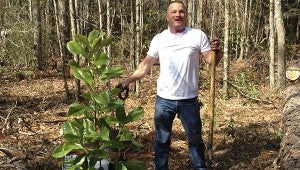Arboretum Paths: Plant a native tree in your spring garden
Published 7:00 am Wednesday, May 7, 2014

SOUTHERN MAGNOLIA: Arboretum grounds manager Terry Johnson plants a Southern Magnolia into the beech-magnolia forest exhibit near the Visitor Center.
Photo by Pat Drackett
By Patricia Drackett
Director, Crosby Arboretum/ MSU Extension
Are there areas in your yard that are calling out for a new tree? Although fall and winter offer a good time for planting because of the long time period ahead for new roots to establish a foothold before hot weather, spring is still a popular time of year for installing new plants in the garden.
The Crosby Arboretum provides an ideal setting to enjoy a stroll through our grounds while perusing the exhibits and taking note of the trees you might like to include in your home landscape. Species we admired earlier in the year for their attractive flowers – such as mayhaw (Crataegus opaca) and southern crabapple (Malus angustifolia) – are now festooned with fruit.
When you exit our visitors’ parking area, take a gander at the southern crabapple planted on either side of the gate. Small green apples are trimming the branches and are rapidly increasing in size. Later, they will fall to the ground and offer a buffet for hungry deer, fox, raccoon, or turkey.
Other plants may not have drawn your attention in the early spring because they have less showy blooms, such as Elliot’s blueberry. Its tiny bell-shaped flowers may have delighted a few detail-oriented visitors, but the plump fruit that now dots the lacy foliage of this shrub – known as huckleberries by local folk – will certainly catch your eye, as well as that of passing wildlife.
Observe the environmental conditions where you see certain trees growing at the Arboretum. Then, look for areas in your home landscape that replicate these conditions, such as soil moisture, topography, and sun exposure. By matching the “right plant” to the “right place”, you will have a much higher degree of success and survivability.
Recently, this column referred to some of the points made by entomologist and author Dr. Doug Tallamy, during his presentation for the Arboretum’s annual lecture series this past March. His talk focused on the significant relationship that exists between insects and the native plant species with which they have co-evolved. Dr. Tallamy gave examples of how planting more native species can improve an area’s biodiversity, and in other words, support more wildlife species.
It was interesting to hear about this role of our native insect species. Usually, we think of insects as being pesky to us and to our plants, but only a small percentage of insects are actually truly pest species. Most are essential components of ecosystems, and many provide valuable services to humankind such as pollinating crops or decomposing waste.
Dr. Tallamy pointed out that most plants have developed some type of chemical protection within their leaves that tastes bad that insects won’t want to eat them. With very few exceptions, only those insect species that have shared a long history with a plant are able to develop the adaptations needed to be able to digest these chemicals. They become specialized over time to be able to eat only these certain plants. When you present insects on this continent with plants that have evolved elsewhere, the chances are good that our insects will not be able to eat these “alien” plants.
Now, you might think that this is a fantastic thing, to have plants that insects don’t want to eat, but Dr. Tallamy asked us to consider the difference we can make to our local food webs by planting a native tree that is able to support hundreds of local insect species versus an ornamental species from another continent that may support only a few species. He wasn’t suggesting we need to plant only natives in our landscape, but to simply understand the value that native plants can contribute to our local biodiversity.
The month of May will bring several great opportunities to join us for field walks to learn more about Mississippi’s native plants. Field trips and botany walks will be held on May
17 and May 31. For more details or to sign up for a program, call the Arboretum office at (601) 799-2311, or visit www.crosbyarboretum.msstate.edu. We are open Wednesday through Sunday from 9 a.m. to 5 p.m. and are located in Picayune, off I-59, Exit 4, at 370 Ridge Road (south of Walmart and adjacent to I-59).
FOR FURTHER EXPLORATION:
The MSU Extension publication No. 2402, “Establishing a Backyard Wildlife Habitat” is available for download at www.MSUcares.com. This comprehensive document covers the basic needs of wildlife and provides lists of plant species that will attract birds, hummingbirds, and other wildlife, as well as giving tips for configuring your landscape for maximum wildlife benefit.




